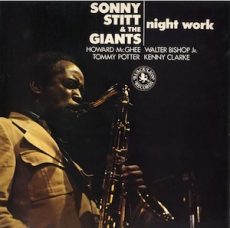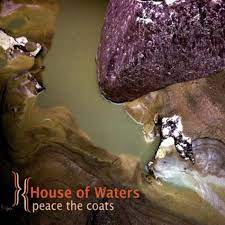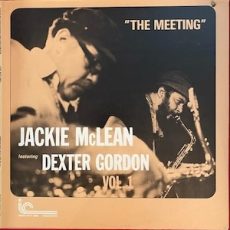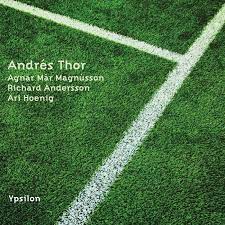
Requisites
Night Work ~ Sonny Stitt And The Giants | By Eddie Carter
As a teenager growing up in the late sixties and early seventies, I was exposed to and enjoyed many different jazz saxophonists, thanks to my Mom and my uncles Ben, Bob, Emmanuel, and Mr. Leo Mintz. Sonny Stitt has always been one of my favorites. He enters this morning’s spotlight with Night Work (Black Lion Records BLP 30154) by Sonny Stitt and The Giants. It was initially recorded in 1967 but not released until 1974. Sonny Stitt is featured on alto sax (A1, A2, B1, B4), and the other giants are Howard McGhee (tracks: A1, A2, B3, B4) on trumpet, Walter Bishop Jr. on piano, Tommy Potter on bass, and Kenny Clarke on drums. My copy is the U.S. Stereo release (Black Lion BL-307).
The opener, Night Work by Howard McGhee, is an upbeat invitation to sit back, relax and ride the rhythm of the ensemble’s swift melody into Sonny’s opening solo. Howard has the next spot and delivers the goods with considerable agility, followed by Walter’s impeccably delivered reading. Howard and Sonny join forces to exchange a few ideas together before Kenny joins their conversation, leading to the reprise and ending. Matter Horns by the team of Eiger and Jungfrau slows the pace to mid-tempo for Stitt’s easygoing theme and relaxing opening statement. Howard comes in next with a pleasantly flowing solo. Walter continues the bluesy groove in the third reading. Tommy and Kenny add a great deal of pleasure to the next two interpretations ahead of the quintet, trading a few riffs together before the climax.
The second side starts with a gorgeous quartet rendition of Loverman by Jimmy Davis, Roger Ramirez, and Jimmy Sherman. It is a beautiful jazz standard that Sonny and the rhythm section begin with their exquisite melody. Sonny captures the standard’s delicacy and tenderness in the song’s lone interpretation preceding the foursome’s elegant conclusion. Both horns take a break for the rhythm section’s lovely version of Satin Doll by Duke Ellington, Billy Strayhorn, and Johnny Mercer. Walter shows a great deal of respect to Duke as he leads the trio through the introduction and melody. He continues making a personal impression on the song’s solo while Tommy and Kenny provide the support ahead of the theme’s restatement and close.
Howard steps into the spotlight with the rhythm section for Don’t Blame Me by Jimmy McHugh and Dorothy Fields. The trumpeter’s piercing tone penetrates the introduction before settling down for a pretty melody. Howard has an exceptionally fine spot as the song’s only soloist, complemented by the trio’s accompaniment culminating in a tender finale. Hello by Howard McGhee brings the album to a close and this song will remind listeners of Milt Jackson’s Bags’ Groove. McGhee’s muted trumpet shares the duties with Stitt during the melody. McGhee steps up first with an excellent muted solo. Bishop gets something cooking in the second statement, and then Stitt takes the spotlight next. Clarke gets the last word in an exchange with both horns ahead of the theme’s reprise and ending.
Alan Bates produced Night Work, and Helmuth Kolbe was behind the dials of the recording. The album’s sound quality is quite good with a solid soundstage that transports the listener to the studio as the musicians are playing. Sonny Stitt was one of the best jazz saxophonists, with a career lasting nearly four decades and a recorded discography of over one hundred albums. He was also proficient on the tenor sax and baritone sax. This is one of his best records, in my opinion, and if you are in the mood for a great sax album, I invite you to check out Night Work by Sonny Stitt and The Giants on your next record-shopping trip. If you’re looking to start a collection of his music, it’s worth seeking out for your library and a title I’m sure you’ll enjoy!
~ Don’t Blame Me, Loverman, Satin Doll – Source: JazzStandards.com © 2024 by Edward Thomas Carter
More Posts: choice,classic,collectible,collector,history,instrumental,jazz,music,saxophone

Daily Dose Of Jazz…
Anne Mette Iversen was born March 15, 1972 in Aarhus, Denmark. She studied classical piano at the Royal Academy of Music in her hometown and bass at the Rhythmic Conservatory of Music in Copenhagen, Denmark and The New School University in New York City.
Living in New York City from 1998 to 2012 Iversen co-founded the Brooklyn Jazz Underground in 2006 and is co-owner of the related record label Brooklyn Jazz Underground Records, which was formed in 2008. She works as a sideperson in various settings and as a freelance composer.
Currently based in Berlin, Germany. Iversen was Composer in Residence for Sweden’s Norrbotten Big Band in 2016. Anne’s composing is recognized for her ability to integrate classical music with jazz ensembles. She is influenced by major classical composers as well as jazz and Brazilian artists and composers.
Bassist Anne Mette Iversen has recorded ten albums between 1998 and 2020 and continues to perform, record and compose.
More Posts: bandleader,bass,composer,history,instrumental,jazz,music

Daily Dose Of Jazz…
Moto Fukushima was born in Kobe, Japan on February 23, 1978 and received the Outstanding Performer Award before graduating Summa Cum Laude from Berklee College of Music. His musical style is a unique combination of Western classical music, Japanese traditional music, and African-inspired music of South America, which is evident in his jazz improvisation. His playing is characterized by a remarkable blend of finesse, subtlety, and power.
He is a co-leader of the Brooklyn-based power trio, House of Waters. The band has released two albums on the Grammy Award-winning group Snarky Puppy’s GroundUp label, with the first album reaching #2 on the iTunes World Music chart, and the second album hitting #4 on the iTunes Jazz chart.
His music has been featured in the Sports Emmy Award-winning piece on ESPN’s E60, and he won 3rd place in the International Songwriting Competition in 2014. He has also been the recipient of the ASCAP Plus Award.
Moto has collaborated with Mike Stern, Leni Stern, Karsh Kale, Dave Weckl, Dave Eggar, Big Apple Circus, Alex Skolnick, and Gil Goldstein. Six-string bass player, composer, and shamisen player Moto Fukushima, currently based in New York City, continues to perform and record.
More Posts: bass,composer,history,instrumental,jazz,music,shamisen

Requisites
The Meeting, Vol. 1 ~ Jackie McLean Featuring Dexter Gordon | By Eddie Carter
I was looking for something to listen to after dinner a few nights ago when I came across a title I hadn’t heard in a while by two of my favorite saxophonists, Jackie McLean and Dexter Gordon. This morning’s record from the library is The Meeting, Vol. 1 (SteepleChase SCS-1006). It hit the Danish and Japanese stores in 1974 and is the first of two live albums recorded a year earlier on July 20 and 21 at Montmartre Jazzhus in Copenhagen. The front line is Jackie McLean on the alto sax and Dexter Gordon on the tenor sax. The supporting cast for both sets is a magical rhythm section: Kenny Drew on piano, Niels-Henning Ørsted Pedersen on bass, and Alex Riel on drums. My copy is the 1976 U.S. Stereo reissue (Inner City IC 2006).
Side One opens with Jackie’s introduction of the quintet ahead of the rhythm section’s introduction to All Clean by Dexter Gordon. Both horns enter next to introduce the vibrant melody. Dexter goes to work first on a lengthy opening solo. Jackie checks in next and keeps the flame burning. Kenny makes a vigorous contribution next, and then Niels-Henning takes a brisk walk in the following reading. Dexter and Jackie return to have a spirited conversation, leading to the song’s conclusion. Rue De La Harpe by Sahib Shihab begins with the ensemble’s mid-tempo theme. Jackie has the opening chorus and takes command effectively. Dexter flies straight ahead into the following solo, and Kenny keeps things moving with considerable passion until the theme’s climax.
Side Two starts with Sunset, a hauntingly beautiful ballad by Kenny Drew that he initially recorded on Everything I Love. Both horns introduce the song, proceeding to the ensemble’s delicately tender melody. Jackie begins the opening statement gently. Dexter follows with an extremely personal interpretation, and Kenny adds a meaningful comment preceding the theme’s restatement. On The Trail by Ferdé Grofé is the third of five movements in his Grand Canyon Suite. Jackie kicks off the theme’s first chorus. Dexter takes the baton in the second chorus and then makes a distinctive impression on the first solo. Jackie speaks with captivating inspiration in the following reading. Kenny executes a rewarding performance in the closer ahead of the finale.
Nils Winther did double duty on this release. He produced and recorded The Meeting, Vol. 1. The reissue’s sound quality is excellent, with a superb soundstage that transports the listener to a front-row seat in the Montmartre audience as the musicians are performing. Since I have this album in my library, I’ll be on the lookout for its companion, The Source, Vol. 2. If you’re a fan of Jackie McLean and Dexter Gordon, I invite you to attend The Meeting, Vol. 1 on your next record shopping trip. It’s a stellar lineup with great playing from each member of the quintet and a wonderful document of a live set that anyone can revisit anytime the album is on the turntable!
~ Everything I Love (SteepleChase Records SCS-1007), The Source, Vol. 2 (SteepleChase Records SCS-1020) – Source: Discogs.com ~ On The Trail – Source: Wikipedia.org © 2024 by Edward Thomas CarterMore Posts: choice,classic,collectible,collector,history,instrumental,jazz,music,saxophone

Daily Dose Of Jazz…
Andrés Thor was born on December 27, 1974 in Hafnarfjordur, Iceland, a little harbour town near Reykjavík, Iceland. He began his musical studies at age 12 and his initial influences were glitter and hippie rock bands such as Led Zeppelin, The Doors, Jimi Hendrix and Bon Jovi.
During his teens was when he first heard the music of John Coltrane and Pat Metheny which led him to become more fascinated with jazz. He soon started studying with some of Iceland’s finest jazz educators at the FIH music school and after graduating his musical quest brought him to study at the Koninklijk Conservatorium (The Royal Conservatory) in The Hague, The Netherlands in 2000.
Finishing his Bachelors and Masters degrees by 2006 he went on to study under the guidance of Wim Bronnenberg, Peter Nieuwerf, Eef Albers, John Ruocco and Hein v/d Geyn as his main teachers. He also attended workshops and masterclasses lead by Michael Brecker, Kurt Rosenwinkel, John Abercrombie and Avishai Cohen, as well as performing with the late Michael Brecker and the Royal Conservatory Big Band in concert.
Living and studying in the Netherlands lead to the first recording featuring Andrés as a co-leader of the organ trio Wijnen, Winter & Thor. The band featured songs by all members of the trio. Since then he has been based and working in and out of Iceland and has released five albums under his own name and a handful of albums in collaboration. He has been active in various collective projects and as a sideman with bands like ASA trio, Icewegian, The Viking Giant Show, BonSom, Andreas Dreier quartet and Music with Z to name a few.
Thor has been an active performer in Scandinavia, Europe and America, as well as a session musician in studios and educator in Iceland. He doubles on the mandolin, banjo and steel guitars. Guitarist Andrés Thor continues to record and perform blending his positively ambrosial tonal palette with the elegant harmonic substance and incisive, ornamented cross-rhythms.
More Posts: banjo,guitar,history,instrumental,jazz,mandolin,music




